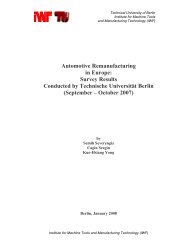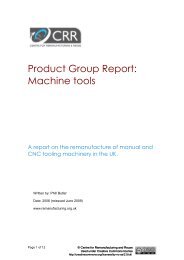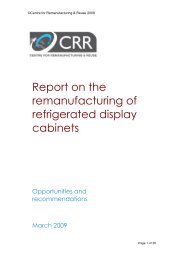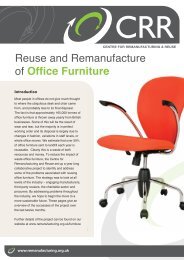Report: rail sector - Centre for Remanufacturing & Reuse
Report: rail sector - Centre for Remanufacturing & Reuse
Report: rail sector - Centre for Remanufacturing & Reuse
You also want an ePaper? Increase the reach of your titles
YUMPU automatically turns print PDFs into web optimized ePapers that Google loves.
Case Study:Rail SectorAn assessment of the remanufacture oftraction and rolling stockWritten by: Phill ButlerDate: 2006 (reissued May 2009)Page 1 of 9© <strong>Centre</strong> <strong>for</strong> <strong>Remanufacturing</strong> and <strong>Reuse</strong>Used under Creative Commons licensehttp://creativecommons.org/licenses/by-nc-sa/2.0/uk/
Page 2 of 9© <strong>Centre</strong> <strong>for</strong> <strong>Remanufacturing</strong> and <strong>Reuse</strong>Used under Creative Commons licensehttp://creativecommons.org/licenses/by-nc-sa/2.0/uk/
Contents1 Overview 42 Vehicles & sub-systems 53 <strong>Remanufacturing</strong> value 64 Technical evolution 75 Reconstructability 86 Reman potential 87 Policy options 9Page 3 of 9© <strong>Centre</strong> <strong>for</strong> <strong>Remanufacturing</strong> and <strong>Reuse</strong>Used under Creative Commons licensehttp://creativecommons.org/licenses/by-nc-sa/2.0/uk/
1 OverviewSince Britain’s <strong>rail</strong> industry was privatised by the conservative government in themid 90’s, the network has seen a large amount of capital investment, both ininfrastructure and rolling stock. The UK still lags behind many of its WesternEuropean counterparts however in terms of quality of service, prices andtechnology. A number of high profile incidents such as the Clapham junction andHatfield disasters did little to improve public opinion, and saw the introduction ofsome of the most complex and expensive safety regulations in Europe. None theless, the <strong>rail</strong>way system is statistically far safer than the road network.Year on year, passenger <strong>rail</strong> travel has increased since privatisation, and someindustry commentator are predicting continued growth as the price of carownership and road congestion escalate. Moves by the government and NetworkRail have improved train punctuality significantly over the past three years, a keyfactor in customer satisfaction. Freight traffic has failed to keep up with theincreases in carriage seen by the road haulage <strong>sector</strong>. This is largely to do withthe greater convenience of road haulage and the need <strong>for</strong> road transport to andfrom <strong>rail</strong> terminals.To understand the <strong>rail</strong> system in the UK, it is necessary to have basic knowledgeof the structure of ownership and responsibility that has emerged postprivatisation. The publicly listed company Railtrack PLC took over control of the<strong>rail</strong> network infrastructure in 1994. Railtrack was entrusted with the maintenanceand improvement of the network, including track, signalling and stations. After aseries of fatal accidents and poor handling of the West Coast mainlinemodernisation program, Railtrack went into administration in 2001, and thecompany was bought out by Network Rail, which now takes responsibility <strong>for</strong> <strong>rail</strong>infrastructure. Train operating companies (TOCs) such as Central trains or Virginoperate franchise agreements to provide services to passenger and freight inagreement with the government and Network Rail. Network Rail receive a fee <strong>for</strong>the use of the <strong>rail</strong> network from the TOCs. The rolling stock is not owned by theTOCs but by one of three leasing companies, known as rolling stock companies(ROSCOs). These are in turn owned by large financial institution such as HSBCand Abbey.There are a number of groups in which users of <strong>rail</strong> services can be classified. Ingeneral, the health of the <strong>rail</strong> industry is dependant on the state of the economy.A healthy economy leads to an increase in both business and leisure travel,which in turn increases passenger numbers. Business user and commuter trafficis relatively unaffected by short-term slumps in economic growth, whereas leisuretravel is particularly affected by low consumer confidence. Freight traffic, whichmainly consists of bulk commodities such as coal, petroleum products and steel,is also insensitive to short term economic trends. These are all important whenexamining remanufacture as confidence in future demand will directly affectinvestment in new rolling stock and refurbishment programs.In a similar way to the aerospace industry, the <strong>rail</strong> <strong>sector</strong> has a culture ofmaximising cost efficiency by reusing components and vehicles where everpossible. Rolling stock has been designed with a lifetime of 30-40 years, and assuch will go through several cycles of remanufacture, either in full or in part. APage 4 of 9© <strong>Centre</strong> <strong>for</strong> <strong>Remanufacturing</strong> and <strong>Reuse</strong>Used under Creative Commons licensehttp://creativecommons.org/licenses/by-nc-sa/2.0/uk/
well developed network of remanufacturers and maintenance depots exists toservice the <strong>sector</strong>, consisting of both OEMs and non OEMs. Some vehiclemanufacturers are now considering product service systems, such as Siemenswho supplied units <strong>for</strong> the TransPennine Express service on the agreement thatSiemens would assume full responsibility <strong>for</strong> maintenance and vehicle availability.This obviously bodes well <strong>for</strong> remanufacture as it is in the interest of Siemens toproduce vehicles that are well suited to reuse rather then replacement. This againmirrors certain aerospace suppliers who have turned to product service systemsto diversify their business, and have found the synergy beneficial to bothcustomer and supplier.The decision to invest in new rolling stock is influenced by a number of factors.The price of a leasing agreement to the TOCs will be higher if the ROSCO hasinvested in new vehicles. This in turn will have consequences <strong>for</strong> the franchiseagreement, which dictates the cost at which the TOC must provide a service-tooffervalue <strong>for</strong> the end user and <strong>for</strong> the government, which still subsidises the <strong>rail</strong>network. Suitability <strong>for</strong> the purpose rather than age is the main factor in rollingstock choice. As the UK <strong>rail</strong> infrastructure is at present unable to allow speeds ofover 125mph, the demand <strong>for</strong> modern high speed trains to reduce journey timesis minimal. Existing fleets of Intercity 125 stock are capable of achieving thesespeeds, although many are now beginning to reach the end of their designlifetimes and will need replacing at some point in the next few years.2 Vehicles & sub-systemsRolling stock is any vehicle that travels on the <strong>rail</strong>way network. There arehundreds of different types of vehicle operating on the network, but to discussthese in detail would be beyond the scope of this report. Five main groups ofvehicle can be identified:Traction units (vehicles to provide motive power to pull either passengeror freight trains).Passenger carriages.Self-propelled passenger vehicles.Freight vehicles.Infrastructure maintenance vehicles.The body of the vehicle and interior fittings usually require refurbishment at thehalf-life refit, assuming no damage occurs from misuse or a collision. Therunning gear will require more frequent remanufacture, and is normally servicedat a fixed mileage interval. Heavy overhaul is usually carried out at betweenPage 5 of 9© <strong>Centre</strong> <strong>for</strong> <strong>Remanufacturing</strong> and <strong>Reuse</strong>Used under Creative Commons licensehttp://creativecommons.org/licenses/by-nc-sa/2.0/uk/
400,000 and 900,000 miles, depending on the vehicle. This involves removal ofthe bogies <strong>for</strong> complete strip down and remanufacture of all systems. The engineor motor and trans<strong>for</strong>mer will also need to be removed and remanufactured atsimilar intervals.A bogie is the part of a vehicle that houses the wheel and axles, suspension,breaking system and in some cases the traction motor. There are usually twobogies on each vehicle, with two sets of wheels on each bogie. The bogies arefree to rotate on the chassis of the vehicle to allow it to negotiate corners. In thepast, the contact surface of a wheel would be re-tyred at overhaul, but the currentpractice is to grind the wheel to recover the finish without re-tyring. This meansthat each wheel has a finite number of lifecycles, after which it will be stripped offits axle and recycled. All other major components of the bogie will beremanufactured repeatedly, and will most likely last <strong>for</strong> the entire lifetime of thevehicle. Only small items such as gaskets and bolts will be renewed as a matterof course.At 5-8 years most vehicles will receive a major overhaul, during which systemssuch as doors and electronics will be serviced, possibly replaced, to bring thevehicle up to current standards and avoid issues of obsolescence. An even morecomprehensive service will be undertaken at 15-20 years (half life), whereinteriors will be completely replaced; the interior will not be remanufactured, ascustomers have increasing expectations of com<strong>for</strong>t and facilities.3 <strong>Remanufacturing</strong> valueIt is hard to place a value on the exact amount of remanufacturing that is carriedout by the <strong>rail</strong> <strong>sector</strong> each year. The Office of National Statistics (ONS) statesthat in 2005, just over £15.5 million was invested in <strong>rail</strong> vehicle refurbishment (halfthat seen in 2004). This does not include however components that are removedand remanufactured as part of heavy overhaul, as this is classed asmaintenance.Because of the very high standard of workmanship employed in the <strong>rail</strong>maintenance <strong>sector</strong>, overhauled components are of a sufficient quality to class asremanufactured. This is vital if vehicle reliability is to be maintained. Delays dueto technical failures are extremely costly <strong>for</strong> TOCs, thus using sub standardcomponents is simply not an option.No individual data is kept on the size of the rolling stock maintenance <strong>sector</strong> bythe ONS. Any such data is collected embedded with that <strong>for</strong> networkinfrastructure maintenance. What is certain is that TOCs will always opt toremanufacture components and systems where ever possible, and this decisionis driven purely by cost. It is highly unlikely that any intervention by policy couldincrease the value of remanufacture due to scheduled overhaul.Page 6 of 9© <strong>Centre</strong> <strong>for</strong> <strong>Remanufacturing</strong> and <strong>Reuse</strong>Used under Creative Commons licensehttp://creativecommons.org/licenses/by-nc-sa/2.0/uk/
4 Technical evolutionRailway technology has moved on substantially since much of the UK’s fleet wasbuilt. Britain, however, has been slow to invest in the new generation of highspeed trains – the aging track and signal system are not suitable <strong>for</strong> speeds ofover 125mph and the crowded network is used by slower regional and freighttraffic, meaning timetabling express services poses a real problem <strong>for</strong> schedulers.Plans to implement moving block signalling, a system that would allow higherspeed trains to use the network, proved to be a costly failure. Virgin trains haspurchased a fleet of Pendolino high speed vehicles, but they are unable to utilisetheir full potential due to network speed restrictions. For the time being, the UKhas no market <strong>for</strong> the latest high speed vehicles; the drive to replace existingstock is minimal.Progress has been made in other areas, however, many of which allow <strong>for</strong>retrofitting of older vehicles. Train interiors in particular are becoming ever moreadvanced and com<strong>for</strong>table, offering passengers facilities such as power sockets,wireless internet access, bars and shops, and electronic in<strong>for</strong>mation displays.There has also been a move to eliminate slam-door vehicles from the network infavour of electronic sliding models. Older vehicles have been retro-fitted with theslide-door system to comply with the new standard. More advanced warningsystems have also been retrofitted to older stock to reduce the risk of accidentsdue to driver error. The ability to retrofit these systems means that older vehiclescan remain in service along side newer designs operating with the same systems.In terms of vehicle efficiency, whilst engine technology has moved on to producemore efficient engines that emit less harmful emissions, vehicles have actuallybecome heavier to accommodate the greater levels of passenger com<strong>for</strong>t andcontrol and communication equipment. Modern vehicles are in general no moreefficient, or only marginally so, which means that it is difficult to make a definitivestatement on whether it is more environmentally wise to remanufacture an oldervehicle or purchase new to achieve improved fuel consumption. Some vehiclescan benefit from retrofit of an entirely new engine, and this is dictated purely bythe envelope of space and the main inputs/outputs of the existing engine. The1997 vintage Turbo Star vehicles that run regional services can be retrofitted witha Euro level 3 unit to reduce harmful emissions and improve efficiency.What can make real gains in terms of efficiency is switching to electric rather thandiesel power sources. Electric trains are cleaner and more efficient, as well asbeing better suited to routes with steep gradients. Whilst the infrastructure costsof electrifying the network are huge, rising fuel prices and pressure to reducedependence on oil may see more electrification projects undertaken. This wouldrequire new vehicles as it is not economically viable to convert diesel vehicles torun on electrical power. Such a move could affect the market <strong>for</strong> remanufactureddiesel vehicles, as this would produce a surplus of old technology on the network.Further efficiency gains are being achieved by the Virgin Pendolino fleet, whoseregenerative breaking system actually feeds the national grid with electricity, andreduces use of consumable break pads. These electrically powered trainsgenerate an estimated 55 million kWh of electricity during the course of a year, inwhich they will cover 13 million miles. This is not a system that can easily bePage 7 of 9© <strong>Centre</strong> <strong>for</strong> <strong>Remanufacturing</strong> and <strong>Reuse</strong>Used under Creative Commons licensehttp://creativecommons.org/licenses/by-nc-sa/2.0/uk/
fitted to older vehicles. If government commitments to reduce CO 2 emissionsmeans that such systems become mandatory, there could be a rapid uptake ofnewer vehicles which would again alter the market <strong>for</strong> remanufacture.5 ReconstructabilityWith such a long design lifetime, <strong>rail</strong> vehicles are constructed with maintenance inmind. They are intended to be completely deconstructed and remanufactured atleast once, with many systems experiencing regular removal and remanufacture.It is essential then that vehicles do not have designs that might inhibitreconstruction. Although it may not be possible to upgrade every system on aspecific vehicle, remanufacture is always technically viable.6 Reman potentialThe UK has a stable demand <strong>for</strong> regular maintenance of its 12,000 strong <strong>rail</strong>vehicle fleet. The future of remanufacture is secure in this area, and volume isdependant roughly on the number of miles covered by the fleet. It is there<strong>for</strong>eunlikely that any significant change will be experienced in the near future.Different strategies of preventative rather than responsive maintenance will havea small effect on the frequency of overhaul, but not to such an extent that it willhave a major bearing on the remanufacturing <strong>sector</strong>.If a marked increase in <strong>rail</strong> travel is seen in the future then remanufacturing willbenefit, as more vehicles will be required, all of which will require regularmaintenance and overhaul. Conversely, if passenger numbers fall, TOCs will runfewer services, resulting in fewer vehicles miles, and less need <strong>for</strong> overhaul. Anysuch change will be as a result of prolonged changes in <strong>rail</strong> usage, as timetablingand delays in procuring vehicles acts as a buffer against short term demandfluctuations. Changes in vehicle type will also have little effect as even newvehicles require routine overhaul.Less predictable is the market <strong>for</strong> complete vehicle remanufacture. The size ofthis <strong>sector</strong> is defined annually by only a handful of contracts, and thus its valuewill fluctuate dramatically from year to year. This is far more dependant oneconomic stability and confidence than the overhaul market. Operators willchoose to run on old stock without carrying out a program of expensive upgradesif confidence in passenger or freight growth is not good: Most vehicles willundergo one complete remanufacture at their half life. ROSCOs or TOCs mayPage 8 of 9© <strong>Centre</strong> <strong>for</strong> <strong>Remanufacturing</strong> and <strong>Reuse</strong>Used under Creative Commons licensehttp://creativecommons.org/licenses/by-nc-sa/2.0/uk/
choose to carry out this process more regularly in times of high <strong>rail</strong> confidence toimprove passenger perception of the service.Other than punctuality, the way a train looks and how com<strong>for</strong>table it is will be themajor factor in how satisfied a customer is with their <strong>rail</strong> experience. A completerefit can be a cost effective way <strong>for</strong> TOCs to extend the life of their vehicles, andstill provide customers with up to date cabin equipment and com<strong>for</strong>t levels.Similarly, freight operators will refit wagons to fulfil the needs of a particularcustomer. The government can influence this decision to a certain extent with thefranchise agreement issued to a particular route. By fixing the cost at which theTOC must operate the route, there is an indirect barrier that can be imposed as tothe amount that a TOC can spend on rolling stock.If the UK <strong>rail</strong> network infrastructure remains largely unchanged then there will belittle change to the types of vehicles on the system. If however more of thenetwork is electrified or high speed sections are developed, then the current stockwill need to be replaced with new, thus remanufacture of mid-life vehicles will nodoubt see a period of decline, as a surplice of certain types of vehicle will occur.There is also a small amount of remanufacture of vehicles that have reached theend of their service lifetime, but are to be preserved on heritage <strong>rail</strong>ways as anexample of their class. This is not limited to steam locomotives, with all types ofvehicle being restored to display <strong>for</strong> the public. This is usually carries out byamateur enthusiasts and does not represent a particularly important <strong>sector</strong> interms of volume of vehicles.7 Policy optionsWith the levels of remanufacturing already seen in the vehicle overhaul <strong>sector</strong>, itis unrealistic to suggest that further benefits could be made by policy. There aredivergent views on the quality of remanufacturing in the <strong>sector</strong>, suggesting thatthere is a general needs <strong>for</strong> harmonisation of standards, definitions andwarranties.The real influences on the rolling stock remanufacturing industry will come notdirectly from policy related to <strong>rail</strong> vehicles, but from the wider implications ofgovernment transport policy, and the extent to which it is prepared to invest in theaging <strong>rail</strong> infrastructure in the UK. If the UK is to meet its ambitious CO 2reduction targets, there will have to be some solution found to reduce our relianceon road vehicles. It is likely that part of this solution will involve diverting sometraffic onto the <strong>rail</strong>ways. More traffic means more vehicles to maintain andremanufacture. A more prosperous network could also see more regular carriageremanufacturing programs to maintain higher standards of passenger com<strong>for</strong>tand the most up to date communications facilities.Page 9 of 9© <strong>Centre</strong> <strong>for</strong> <strong>Remanufacturing</strong> and <strong>Reuse</strong>Used under Creative Commons licensehttp://creativecommons.org/licenses/by-nc-sa/2.0/uk/












